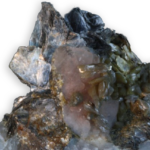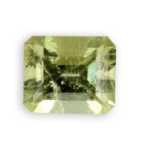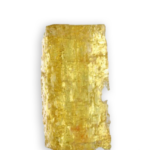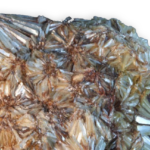
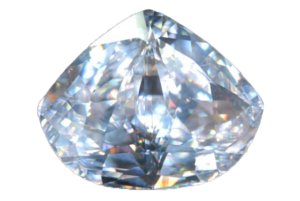
diamond
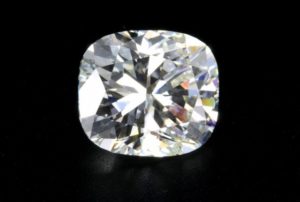
diamond cushion cut
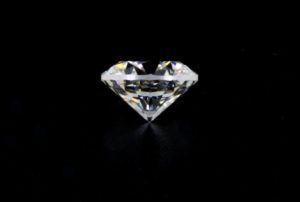
side view of brilliant cut diamond
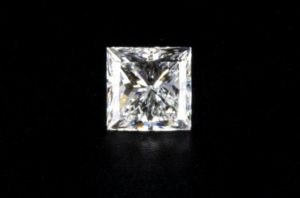
diamond crystal from Guinea Conakry
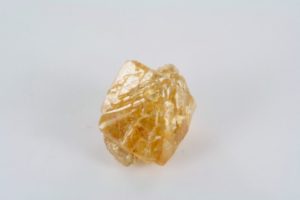
twinned diamond from Brazil
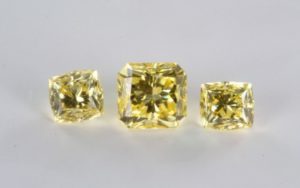
jonquille diamonds from Borneo
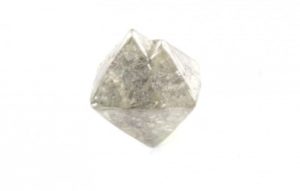
Russian diamond twin
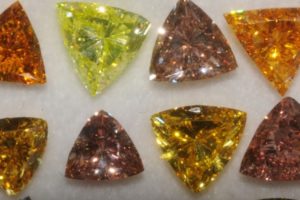
colored diamonds
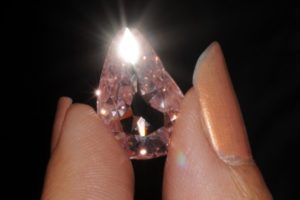
the Conde pink diamond
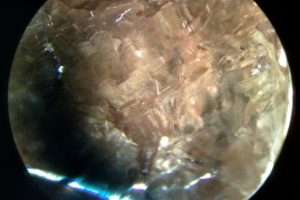
characteristic negative twinning three phase type inclusions with triangular shape
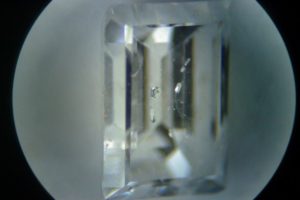
solid like inclusion, peridot
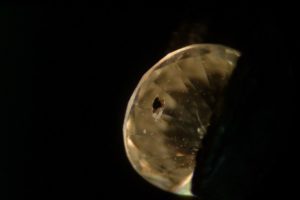
solid like inclusion : garnet crystal
Detailed sheet
diamond
This gem, the best known and most prestigious, is named after its hardness, “adamant” in Greek, which means unconquerable because there are no known naturally occurring minerals that are harder than it. Pure and white, it has an incomparable brilliance, and it sparkles in all its glory, all the colors glow when its moved slightly … this is due to its ability to scatter light, or to decompose white light into all the colors of the rainbow. The contrast between its perfect clarity and colorless lights made it a unique stone.
Its abrasion resistance is about one hundred and fifty times that of the ruby and sapphire but it varies depending on the crystal faces, this allows to cut the diamond … with diamond powder.
It is estimated that the most recent diamonds are dating back 70 million years, the oldest ones being aged 2.5 billion years. The diamond is formed very deep (200 + km ) under the action of great pressure (55-60 kbar) and a very high temperature (1700 ° C) and rise to the surface during volcanic activity.
This is the hardest material known, is the standard hardness of 10 on the Mohs scale.
Symbol of mightyness and power since ancient times, St. Louis forbade women to wear it, but Agnes Sorel and Mary of Burgundy received it as a pledge of love. It was Jean-Baptiste Tavernier, who favored during the the seventeenth century with Louis XIV, the passion for diamonds.

CHEMICAL CHARACTERISTICS
C
carbon

PHYSICAL CHARACTERISTICS
Main color
colourless
Other colors
blue, brown, yellow, black, orange, pink, red, green
virtually all the existing nuances, except violet
Color of streak
white
Luster
adamantine
Hardness
10.0 to 0.0
Density
3.50 to 3.53
Cleavage
perfect
Fracture
uneven
crack with very little flat parts

OPTICAL PROPERTIES
Transparency
transparent
Also translucent, opaque
Refractive index
2.417 - 2.419
Double refraction
0.000
none, isotropic but some crystals exhibit polarization anomalies
visible double refraction
No
Dispersion
0.044(0.025)
Pleochroism
absent
Number of colors
1

brown diamond spectrum system
Fluorescence
variable
sometimes blue to green
Inclusions
black particles: graphite, peridots, garnets, small internal crystals of colorless diamond

CRYSTALS PROPERTIES
predominant octahedras, sometimes perfect cubes, exceptional twins dodecahedra, tetrahedra.
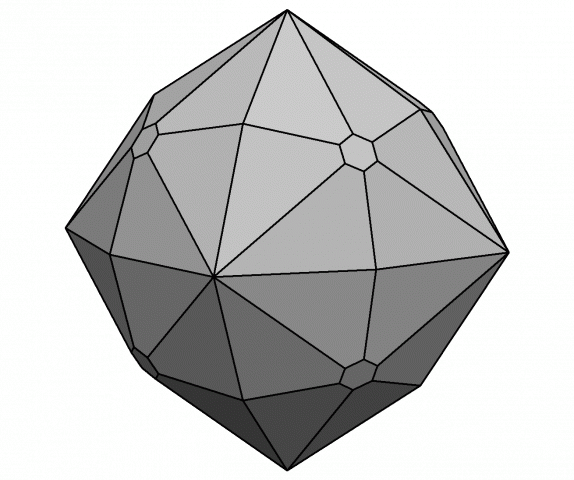
crystals system
cubic

OTHER INFORMATIONS
Astrological sign
Aries, Cancer, Leo, Libra, Pisces, Scorpio
Month
april
Chinese astrological sign
Dog

APPROACHING GEMS
Exploited
sites
Until the eighteenth century, diamonds came from India where they were extracted at least 2000 BC and mines were operating at Visapour (in 1430) and Golconda (in 1662).
In 1725, the Portuguese Leme do Prado notes that gaming chips of the gold miners of the Rio de Marinhos (Brazil) were diamonds, and he began to search them in Minas Gerais. The diamonds were always found in alluvial sands: the secondary deposits. But in 1867, the first mine was opened in a primary deposit in South Africa: a stack of volcanic origin called “pipe” full of rocks more or less rich in diamonds (kimberlites), the most famous being that of Kimberley exploited manually from 1871 to 1908: a hole diameter of 400 m and 1070 m deep (big hole) which produced 14.5 million carats and in 1914 was abandoned as not sufficiently profitable.
Australia is the One of the biggest producers since 1986.
Guinea has diamonds of excellent quality, in 1993, a 235-carat diamond was there discovered and sold for 8 million U.S. dollars.
In Russia, where some”placers” were known in the Urals in 1829 without operating them, alluvial deposits and chimneys were discovered in Siberia after 1949.
China is now one of the producers thanks to some kimberlite “pipes”.
In Namibia some alluvial deposits, which anyway come from South Africa and were discovered in 1908, are on the west coast of Namibia, buried under a hundred feet of rock. Because sediments are also based at sea, they are pumped using special vessels. Nearly 90% of stones are gem quality.
Today, around twenty countries provide diamonds: Zaire remains a major producer since 1907, Botswana, Angola, Ghana (first discoveries in 1919 at Tarkwa and Oda), Central Africa, Venezuela, Liberia (discovered in 1935 in the western region). Canada is becoming a major producer since 2004.
use in jewelry
The best known use is in “solitary”: unique self sufficient stone, it can also be surrounded by “satellites”, smaller stones around it. It combines with all other gems, without denaturing them, putting them in value.
The most famous cut is called “brilliant”, with 57 facets, the stone has then concentrated five times more light than its volume would allow, without the set of facets that reflect the light through the top, there are many kinds of cuts : the cushion, the pink, the emerald, the square, baguette, heart, oval, the marquise, the pear, trillion which is triangular …
The value of a diamond depends mainly on four criteria, the “four Cs”:
The “C” indicating its Carat size as measured by its weight which is expressed in carats, a carat = 0.2 grams.
The “C” of Clarity: the more a diamond is pure, the more it is rare and expensive, especially if it’s big. A small diamond of 0.10 carats is easy to find completely pure, but imagine a pure 10 carat diamond … It is characterized by the visibility and the amount of inclusions that there are inside the stone, their position and color, and if they are visible, to the naked eye, or a magnifyer… The purest diamonds are IF then VVS, VS, SI, I (SI and I are qualities where the inclusions can be seen to the naked eye).
The “C ” for Color : the more the diamond is pure white, the more rare and expensive it is. The color is characterized by letters : the white of white” D “and then following E, F, G, H etc. … U.S. classification used worldwide. The DEF group of colors is classified as “river” quality or exceptional white …
The fourth “C” is the quality of the Cut, “C” for “cut” in English: for the diamond to shine at its brightest e with full light, the cut must meet very precise proportions. The quality of polishing of the facets is also involved.
Other criteria are involved in some countries, such as the presence or absence of fluorescence in the stone …
But pure diamonds, delicately colored of beautiful colors are very popular and can be worth far more than the white ones because they are exceedingly rare and very attractive: for example, a red diamond of 0.95 carat cut gloss was purchased for more than 926,000 dollars at Christie’s in 1987 and most recently in 2010, a pink diamond of 24.78 carats was sold $ 46 million by Sotheby’s : its absolute peak.
The diamond is also used in industry for its extreme hardness, the price then being 40 to 1000 times lower for this type of stones.
The diamond is the stone of the 10th anniversary year of marriage but also the stone of the 60th wedding anniversary.
Daily care
and precautions
While of an unmatched hardness, it is sensitive to shocks. It can be cleaned with warm water mixed with dishwashing liquid, rinsing with alcohol. Do not “boil” it in water as advocated by some: cleaning would be perfect but with the risk that the diamond, continually striking the container walls, gets damaged by shocks, or “cook” after evaporation of the water!
It is very sensitive to extreme heat and sudden temperature changes: jewelers should be careful in making welds on jewelry: a diamond exposed to the torch becomes whitish. It is insensitive to household products.
imitations and
treatments
The diamond commercial value and the ease with which it can be confused with other materials sparked many initiatives. Doublets with a diamond crown and cylinder head made of various materials have been marketed as rhinestones, a lead glass. Synthetic stones can imitate it, like Fabulite, the YAG ( Yttrium aluminium Garnet ), the GGG, the djévalite, the linobat, the synthetic zirconium oxide, the synthetic moissanite.
We know how to synthesize it in a gem quality since 1970, before these syntheses were only marketed for industry, from 1954 they began to imitate the natural stone. Since the early 2000s, we can find on the market yellow synthetic diamonds, cut and mounted.
The current color of a diamond can also be modified by radiation in order to make it more attractive and therefore more expensive. Various treatments of varying complexity (introduction of resin, lead glass, bleaching …) seek to improve the quality of lower stones. Colored diamonds may undergo radiation or be subjected to a process called “diffusion” which incorporates in the diamond a surface layer of color. Black diamonds can be obtained by graphitization.
improvements
Any change in color or purity of the diamond should be noted on the certificates. Some diamonds may be “laundered” by High Pressure High Temperature (HPHT)
Historical
healing properties
A symbol of purity, the diamond is an exceptional stone, and this in all cultures since antiquity. It has ascribed a considerable power such that the layperson should not be implemented, and even insiders should approach it with extreme caution. According to experts, the user of the diamond must be mentally pure as any disturbance in his thoughts could affect it with evil effects. Associated with azurite on the Crown chakra, its power would become phenomenal, giving intelligence and universal knowledge, understanding and cosmic consciousness, wisdom …
According to different cultures, religions and regions, it would have many different powers: it would give courage, absolute power, and would have a positive action (heart chakra) on blood and its central organ, the heart, which would improve purity. It would help to identify the betrayals (Throat Chakra) and appease the demented (Third Eye). It would help to gain trial court if the cause is just, would protect against poisoning by stings or bites, temper an excessive sexuality (Sex Chakra). A symbol of clarity and brightness, it would prove beneficial for eye disorders.
When they are colored, the diamonds, in addition to the above virtues, would hold those assigned to the same colored stones.
historical stones
and related legends
De Beers, a name related to diamond: it is a group founded in 1888 by Cecil Rhodes who operated a merger between De Beers and Kimberley mines to create the “London Diamond Syndicate”, and has accumulated a vast fortune by selling diamonds. It is Ernest Oppenheimer, a German envoy in South Africa during the Boer War, who originally started in 1917, the Anglo-American Corporation. Eight years later, he bought the “Union” and in 1933 organized the London market by founding the Diamond Corporation Ltd. which brought together the african producers and the Central Selling Organization, a cooperative serving also in London, in order to negotiate the stones from South Africa, Botswana and Namibia. In 2005, less than 25% of global diamond trade is outside De Beers control (Brazil, Venezuela, Ivory Coast, Ghana).
The Hope, the “big blue diamond” was marked by a bloody route. Acquired in the legendary mines of Golconda in southern India, by the French Jean-Baptiste Tavernier, it was recut to weigh 45.35 carats before being resold in 1669 to Louis XIV. Stolen in 1792, it reappeared in London in 1830, where is acquired by a banker, Mr. Hope, who gave it its name. Sold to a jeweler in New York, then to a Russian prince and then to a Ottoman Sultan, it was finally bought by the american millionaires McLean. The unhappy fate, even tragic, of its successive owners, assign it an evil power.
The largest diamonds known are : The Cullinan I, from South Africa (1905), weighed 3,106 carats before its cut. Purchased in 1907 by the Transvaal government and gifted to King Edward VII of England to sign peace after the Boer War, it was cut by the Asscher brothers in Amsterdam, which divided it into 105 diamonds, including the Great Star of Africa, pear-shaped cut (530 cts) crimped onto the scepter of the Queen of England and kept at the Tower of London. The Cullinan II, one of the fragments, weighs 317.40 carats. Colorless, cushion-cut, it is also kept at the Tower of London.
The Great Mogul found in India in 1650 (787 cts at the origin), egg cut in half and reduced to 280 carats, colorless to pink deemed lost since 1747. The De Beers Centenary, from South Africa and exceptionally white, 520 carats rough, 273.85 cts once fancy cut, belongs to the De Beers. The Jubilee, yellow diamond from South Africa (1888), 428.5 cts Gross, 234.35 cts. once cushion cut. The Orloff, from India, white with a slight blue-green shade, cut in half egg with rosette above, weighing 189.6 carats, was bought by Prince Orloff for Catherine the Great. It adorned the imperial scepter held in the Kremlin.
Venez visitez
notre site web
voillot-joaillier.fr
Lorem ipsum dolor sit amet, consectetur adipiscing elit. Ut elit tellus, luctus nec ullamcorper mattis, pulvinar dapibus leo.Lorem ipsum dolor sit amet, consectetur adipiscing elit. Ut elit tellus, luctus nec ullamcorper mattis, pulvinar dapibus leo consectetur adipiscing elit. Ut elit tellus, luctus nec.

